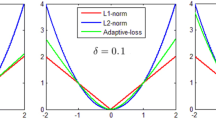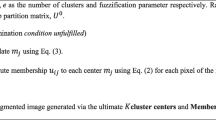Abstract
Partitional clustering is the most used in cluster analysis. In partitional clustering, hard c-means (HCM) (or called k-means) and fuzzy c-means (FCM) are the most known clustering algorithms. However, these HCM and FCM algorithms work worse for data sets in a noisy environment and get inaccuracy when the data set has different shape clusters. For solving these drawbacks in HCM and FCM, Wu and Yang (Pattern Recognit 35:2267–2278, 2002) proposed the alternative c-means clustering with an exponential-type distance that extends HCM and FCM into alternative HCM (AHCM) and alternative FCM (AFCM). In this paper, we construct a more generalization of AHCM and AFCM with Gaussian-kernel c-means clustering, called GK-HCM and GK-FCM. For theoretical behaviors of GK-FCM, we analyze the bordered Hessian matrix and then give the theoretical properties of the GK-FCM algorithm. Some numerical and real data sets are used to compare the proposed GK-HCM and GK-FCM with AHCM and AFCM methods. Experimental results and comparisons actually demonstrate these good aspects of the proposed GK-HCM and GK-FCM algorithms with its effectiveness and usefulness. Finally, we apply the GK-FCM algorithm to MRI segmentation.











Similar content being viewed by others
References
Alon U, Barkai N, Notterman DA, Gish K, Ybarra S, Mack D, Levine AJ (1999) Broad patterns of gene expression revealed by clustering analysis of tumor and normal colon tissues probed by oligonucleotide arrays. Proc Natl Acad Sci 96(12):6745–6750
Antal B, Hajdu A (2014) An ensemble-based system for automatic screening of diabetic retinopathy. Knowl Based Syst 60:20–27
Bandyopadhyay S (2004) An automatic shape independent clustering technique. Pattern Recognit 37:33–45
Baraldi A, Blonda P (1999) A survey of fuzzy clustering algorithms for pattern recognition part I and II. IEEE Trans Syst Man Cybern B Cybern 29:778–801
Bezdek JC (1981) Pattern recognition with fuzzy objective function algorithms. Plenum, New York
Bhatt R (2005) Fuzzy-rough approaches for pattern classification: hybrid measures, mathematical analysis, feature selection algorithms, decision tree algorithms, neural learning, and applications. Amazon Books, Boston
Chang ST, Lu KP, Yang MS (2015) Fuzzy change-point algorithms for regression models. IEEE Trans Fuzzy Syst 23:2343–2357
Chen SC, Zhang DQ (2004) Robust image segmentation using FCM with spatial constrains based on new kernel-induced distance measure. IEEE Trans Syst Man Cybern B 34:1907–1916
Coombs CH, Dawes RM, Tversky A (1970) Mathematical psychology: an elementary introduction. Englewood Cliffs, Prentice-Hall
Dave RN (1991) Characterization and detection of noise in clustering. Pattern Recognit Lett 12:657–664
Dembélé D, Kastner P (2003) Fuzzy c-means method for clustering microarray data. Bioinformatics 19:973–980
Dempster AP, Laird NM, Rubin DB (1977) Maximum likelihood from incomplete data via the EM algorithm. J R Stat Soc Ser B 39:1–38. (With discussion)
Dua D, Taniskidou EK (2017) UCI machine learning repository. School of Information and Computer Science, University of California, Irvine. http://archive.ics.uci.edu/ml
Dunn JC (1974) A fuzzy relative of the ISODATA process and its use in detecting compact, well-separated clusters. J Cybern 3:32–57
Gustafson DE, Kessel WC (1979) Fuzzy clustering with a fuzzy covariance matrix. In: Proceedings of IEEE CDC, California, pp 761–766
Gyamfi KS, Brusey J, Hunt A, Gaura E (2018) Linear dimensionality reduction for classification via a sequential Bayes error minimisation with an application to flow meter diagnostics. Expert Syst Appl 91:252–262
Hathaway RJ, Bezdek JC, Hu Y (2000) Generalized fuzzy c-means clustering strategies using Lp norm distances. IEEE Trans Fuzzy Syst 8:576–582
Izakian H, Pedrycz W, Jamal I (2013) Clustering spatiotemporal data: an augmented fuzzy c-means. IEEE Trans Fuzzy Syst 21:855–868
Jain AK (2010) Data clustering: 50 years beyond k-means. Pattern Recognit Lett 31:651–666
Kaufman L, Rousseeuw PJ (1990) Finding groups in data: an introduction to cluster analysis. Wiley, New York
Krishnapuram R, Keller JM (1993) A possibilistic approach to clustering. IEEE Trans Fuzzy Syst 1:98–110
Lubischew AA (1962) On the use of discriminant functions in taxonomy. Biometrics 18:455–477
MacQueen J (1967) Some methods for classification and analysis of multivariate observations. In: Proceedings of 5th Berkeley symposium, vol 1, pp 281–297
McLachlan GJ, Basford KE (1988) Mixture models: inference and applications to clustering. Marcel Dekker, New York
Pollard D (1982) Quantization and the method of k-means. IEEE Trans Inf Theory 28:199–205
Rand WM (1971) Objective criteria for the evaluation of clustering methods. J Am Stat Assoc 66:846–850
Rohra JG, Perumal B, Narayanan SJ, Thakur P, Bhatt RB (2017) User localization in an indoor environment using fuzzy hybrid of particle swarm optimization and gravitational search algorithm with neural networks. In: Proceedings of sixth international conference on soft computing for problem solving, Singapore, pp 286–295
Ruspini E (1969) A new approach to clustering. Inf Control 15:22–32
Wei C, Fahn C (2002) The multisynapse neural network and its application to fuzzy clustering. IEEE Trans Neural Netw 13:600–618
Werner F, Sotskov YN (2006) Mathematics of economics and business. Routledge, Taylor & Francis Group, London and New York
Wu KL, Yang MS (2002) Alternative c-means clustering algorithms. Pattern Recognit 35:2267–2278
Wu KL, Yang MS (2007) Mean shift-based clustering. Pattern Recognit 40:3035–3052
Yager RR, Filev DP (1994) Approximate clustering via the mountain method. IEEE Trans Syst Man Cybern 24:1279–1284
Yang MS, Nataliani Y (2018) A feature-reduction fuzzy clustering algorithm with feature-weighted entropy. IEEE Trans Fuzzy Syst 26:817–835
Yang MS, Wu KL (2004) A similarity-based robust clustering method. IEEE Trans Pattern Anal Mach Intell 26:434–448
Yang MS, Wu KL (2005) A modified mountain clustering algorithm. Pattern Anal Appl 8:125–138
Yang MS, Hu YJ, Lin KCR, Lin CCL (2002) Segmentation techniques for tissue differentiation in MRI of ophthalmology using fuzzy clustering algorithms. Magn Reson Imaging 20:173–179
Yang MS, Hung WL, Cheng FJ (2006) Mixed-variable fuzzy clustering approach to part family and machine cell formation for GT applications. Int J Prod Econ 103:185–198
Yang MS, Lai CY, Lin CY (2012) A robust EM clustering algorithm for Gaussian mixture models. Pattern Recognit 45:3950–3961
Zadeh LA (1965) Fuzzy sets. Inf Control 8:338–353
Acknowledgements
The authors would like to thank the anonymous referees for their helpful comments in improving the presentation of this paper.
Author information
Authors and Affiliations
Corresponding author
Ethics declarations
Conflict of interest
The authors declare that they have no conflict of interest.
Additional information
Communicated by Carlos Martín-Vide and Miguel A. Vega-Rodríguez.
Publisher's Note
Springer Nature remains neutral with regard to jurisdictional claims in published maps and institutional affiliations.
Rights and permissions
About this article
Cite this article
Chang-Chien, SJ., Nataliani, Y. & Yang, MS. Gaussian-kernel c-means clustering algorithms. Soft Comput 25, 1699–1716 (2021). https://doi.org/10.1007/s00500-020-04924-6
Published:
Issue Date:
DOI: https://doi.org/10.1007/s00500-020-04924-6




